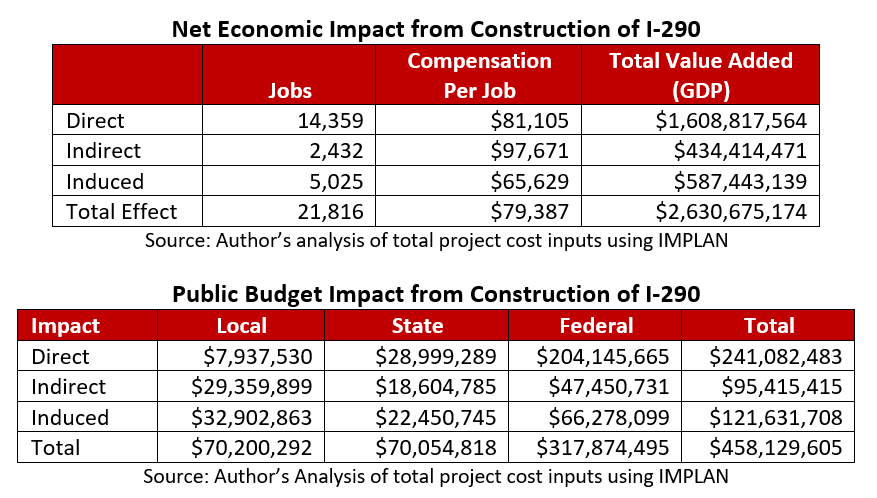Springfield acts to put I-290 in the spotlight under SJR31
La Grange: A multi-modal infrastructure proposal that would modernize the 13-mile stretch of I-290 between I-94 and the I-88/294 interchange would create more than 22,000 jobs, reduce traffic congestion by 25-56%, and dramatically enhance access to jobs for Chicago’s most disadvantaged communities, according to a new study by the Illinois Economic Policy Institute (ILEPI).
Read the Report, “I-290 Reconstruction: Creating a Modern Multimodal Corridor.”
The $2.7 billion project, which combines innovative transit and pedestrian improvements alongside bridge and roadway upgrades, is projected by the Chicago Metropolitan Agency for Planning (CMAP) to provide amongst the best economic, equity, and traffic impacts of any project in the region by 2050. The recently passed Senate Joint Resolution (SJR) 31 encouraged priority funding for the project.
“The I-290 corridor is vital multi-modal infrastructure that’s needed to connect the western suburbs and southern Cook County with the City of Chicago, but it has far exceeded its design life and become one of the most congested and dangerous thoroughfares in the region,” said ILEPI Transportation Director and study author Mary Tyler. “That said, its proposed modernization represents one of the region’s greatest opportunities to create jobs, reduce traffic burdens, and alleviate the economic access burdens facing disadvantaged communities.”
Originally built in the 1950’s alongside CTA’s blue-line, as much as ninety percent of the project’s existing pavement structure is original and exceeds the normal roadway design life of 25-30 years. Of its 44 bridges, 34% are considered “structurally deficient” and 86% are “functionally obsolete,” according to Illinois Department of Transportation (IDOT) data. According to CMAP, vehicle traffic on the stretch has increased by more than 16% since 1984.
In her research, Tyler illustrates the severely limited pedestrian access to adjacent transit facilities, emphasizing safety hazards from narrow sidewalks along busy roads and dangerous crosswalks across I-290 exit and entrance ramps. Tyler also found that over the past decade, I-290 had both the highest number of fatal crashes and the highest fatal crash rate amongst comparable stretches of highway in the Chicago metropolitan area.
“When vital infrastructure becomes obsolete, it carries not just an economic cost, but a human cost as well,” Tyler added. “That’s a big part of what makes the integrated roadway, bridge, transit, and pedestrian improvements tied to this project such a critical priority for the region.”
The proposed I-290 reconstruction project, that was detailed in a 2017 Environmental Impact Statement (EIS) from the Illinois Department of Transportation, incorporates not only bridge and highway upgrades—including a new High Occupancy Toll lane (HOT3+) to support Express Bus service and promote carpooling—but also wider sidewalks, pedestrian safety islands, high visibility crosswalks, lighting, and signals to better facilitate pedestrian/bicycle traffic and transit riders. A concurrent CTA project would upgrade blue line transit facilities, including reconstruction of the entire Forest Park Branch (including track and related infrastructure) as well as stations from UIC-Halsted to Forest Park and six substations.
By 2050, CMAP projects the project will reduce travel times by 25-56%, while increasing the number of jobs within 45 minutes of each household in the region by more than 17,000, and high wage jobs not requiring a college degree for “Economically Disconnected Areas” (EDAs) by more than 1,300. Importantly, it projects that fully 31% of those using the rehabilitated stretch of I-290 will come from EDAs, making the project not only one of the region’s best values to reduce congestion, but to expand opportunity to historically marginalized communities.
Using industry standard IMPLAN modelling, Tyler’s study examined the potential overall economic impact of the project, concluding that it would create nearly 22,000 new jobs paying an average of almost $80,000 per year, while growing the economy by more than $2.6 billion and boosting local, state and federal tax revenues by more than $450 million.

“While I-290 is a prime example of an infrastructure corridor in dire need of attention for safety and traffic related concerns, it is an equally stark example of how such investments can be a game changer for the local economy that uplifts our most historically disadvantaged communities,” Tyler added.
While SJR 31 were recently passed, calling for the project to be prioritized, a funding source has yet to be identified. However, Tyler’s research highlights several potential sources—including tens of millions in toll revenues expected from the project, a new state law providing Tax Increment Financing for certain transit systems, and the possibility of over $300 billion in new federal transportation funds that have been proposed as part of the Bipartisan Infrastructure Investment and Jobs Act.
The Illinois Economic Policy Institute (ILEPI) is a nonpartisan nonprofit organization which uses advanced statistics and the latest forecasting models to promote thoughtful economic growth for businesses and working families.
Cover photo downloaded from Shutterstock subscription.
